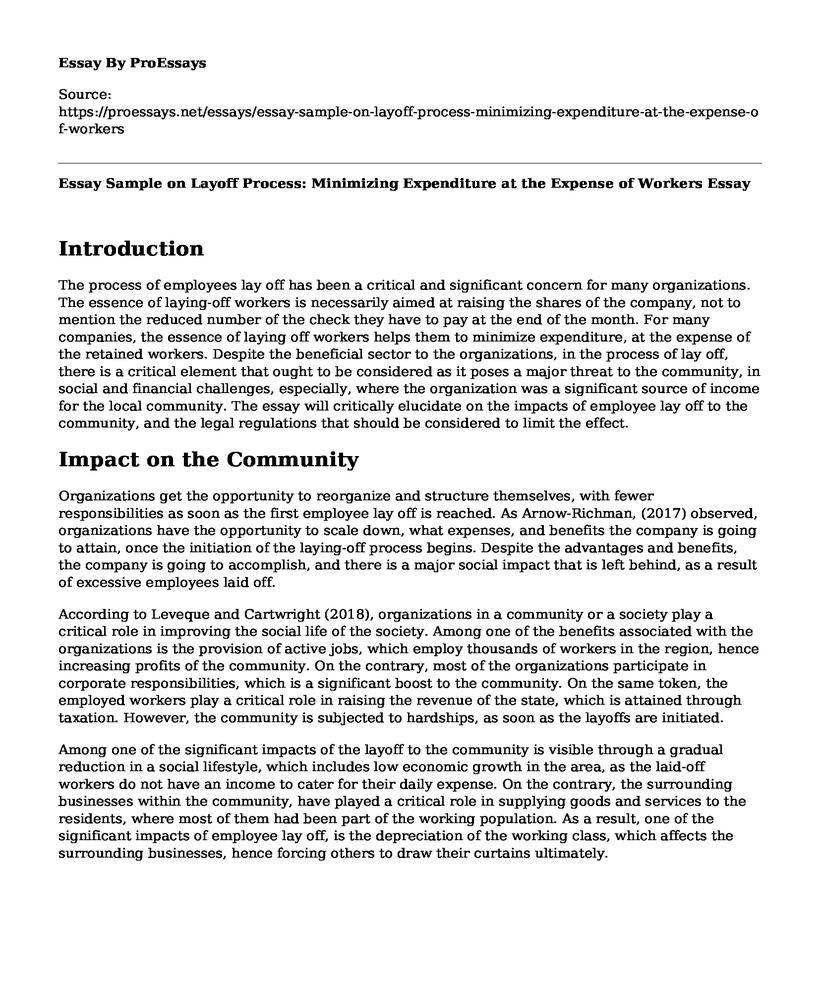Introduction
The process of employees lay off has been a critical and significant concern for many organizations. The essence of laying-off workers is necessarily aimed at raising the shares of the company, not to mention the reduced number of the check they have to pay at the end of the month. For many companies, the essence of laying off workers helps them to minimize expenditure, at the expense of the retained workers. Despite the beneficial sector to the organizations, in the process of lay off, there is a critical element that ought to be considered as it poses a major threat to the community, in social and financial challenges, especially, where the organization was a significant source of income for the local community. The essay will critically elucidate on the impacts of employee lay off to the community, and the legal regulations that should be considered to limit the effect.
Impact on the Community
Organizations get the opportunity to reorganize and structure themselves, with fewer responsibilities as soon as the first employee lay off is reached. As Arnow-Richman, (2017) observed, organizations have the opportunity to scale down, what expenses, and benefits the company is going to attain, once the initiation of the laying-off process begins. Despite the advantages and benefits, the company is going to accomplish, and there is a major social impact that is left behind, as a result of excessive employees laid off.
According to Leveque and Cartwright (2018), organizations in a community or a society play a critical role in improving the social life of the society. Among one of the benefits associated with the organizations is the provision of active jobs, which employ thousands of workers in the region, hence increasing profits of the community. On the contrary, most of the organizations participate in corporate responsibilities, which is a significant boost to the community. On the same token, the employed workers play a critical role in raising the revenue of the state, which is attained through taxation. However, the community is subjected to hardships, as soon as the layoffs are initiated.
Among one of the significant impacts of the layoff to the community is visible through a gradual reduction in a social lifestyle, which includes low economic growth in the area, as the laid-off workers do not have an income to cater for their daily expense. On the contrary, the surrounding businesses within the community, have played a critical role in supplying goods and services to the residents, where most of them had been part of the working population. As a result, one of the significant impacts of employee lay off, is the depreciation of the working class, which affects the surrounding businesses, hence forcing others to draw their curtains ultimately.
The State and Federal Regulations for WARN That Support Laid-off Employees
The mass lay-off should be carried out under strict, and strategic follow-ups to ensure that the economic practices of the affected community, does not significantly affect the families of the drafted employees. According to (Gordon 2018), the Worker Adjustment and Retraining Notification (WARN) Act requires to be given a 60 days' notice of written notice to the intended wave of employees to be laid off. Additionally, the advice should be presented to the employees or the union that governs the workers. On the contrary, the law applies both to the employer, willing to reduce the number of workers through a mass layoff, despite the plan not intending to close. The CEO of the largest employer in rural California should consider the federal regulation outlined in the WARN act before taking the 20% layoff of workers.
Conclusion
In the bottom line, the CEO should take more significant consideration of mass lay off, as stipulated in the WARN Act. The law outlines that workers should be issued with written notice to reduce the impact of the layoff. On the contrary, the dismissal will significantly affect the economic development of the community and their social life.
References
Arnow-Richman, R. S. (2017). Toward an American Law of Redundancy. Comparative Labour and Social Security Law Review, 2, 16.https://ssrn.com/abstract=3058290
Gordon, J. (2018). WARNing: The'Liquidating Fiduciary'Exception Should Not Exist. Harvard Journal on Legislation Online (2018).https://ssrn.com/abstract=3247904
Leveque, K., & Cartwright, A. (2018). Navigate various legal issues surrounding workforce reductions. Campus Legal Advisor, 19(4), 1-5.doi.10.1002/cala.30915
Cite this page
Essay Sample on Layoff Process: Minimizing Expenditure at the Expense of Workers. (2023, Mar 27). Retrieved from https://proessays.net/essays/essay-sample-on-layoff-process-minimizing-expenditure-at-the-expense-of-workers
If you are the original author of this essay and no longer wish to have it published on the ProEssays website, please click below to request its removal:
- Essay Example on Management: Leadership Challenge in an Organization
- The Background and History of the Companies Contending for the Government Contract
- Stakeholders in Health & Social Care Systems - Essay Sample
- Essay Example on IKEA: Motivating Workforce, International HR, and Global Profit
- Essay Example on DuPont Model: Essential Financial Analysis Framework
- Lesson Learned: Most Valuable for Future Performance - Paper Sample
- Human Behavior for Risk Management - Report Example







